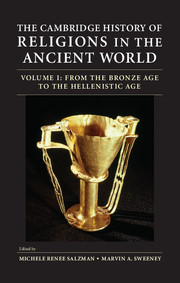Book contents
- Frontmatter
- Contents
- List of Figures and Maps
- List of Contributors
- List of Abbreviations
- Acknowledgments
- Introduction to Volumes I and II
- Introduction to Volume I
- Part I Mesopotamia and the Near East
- Part II Egypt and North Africa
- Part III Greece and the Eastern Mediterranean
- Part IV The Western Mediterranean and Europe
- Suggestions for Further Reading
- General Index
- Index of Citations
- Frontmatter
- Contents
- List of Figures and Maps
- List of Contributors
- List of Abbreviations
- Introduction to Volume II
- Part I Iran and the Near East
- 1 Religion in Iran
- 2 Creating Local Religious Identities in the Roman Near East
- 3 Judaism in Palestine in the Hellenistic-Roman Periods
- 4 Post-70 Judaism in Judea and the Near East
- 5 Christianity in Syria
- Part II Egypt and North Africa
- Part III Greece and Asia Minor
- Part IV Italy, Roman Gaul, and Spain
- Suggestions for Further Reading
- General Index
- Index of Citations
4 - Post-70 Judaism in Judea and the Near East
from Part I - Iran and the Near East
Published online by Cambridge University Press: 05 October 2013
- Frontmatter
- Contents
- List of Figures and Maps
- List of Contributors
- List of Abbreviations
- Acknowledgments
- Introduction to Volumes I and II
- Introduction to Volume I
- Part I Mesopotamia and the Near East
- Part II Egypt and North Africa
- Part III Greece and the Eastern Mediterranean
- Part IV The Western Mediterranean and Europe
- Suggestions for Further Reading
- General Index
- Index of Citations
- Frontmatter
- Contents
- List of Figures and Maps
- List of Contributors
- List of Abbreviations
- Introduction to Volume II
- Part I Iran and the Near East
- 1 Religion in Iran
- 2 Creating Local Religious Identities in the Roman Near East
- 3 Judaism in Palestine in the Hellenistic-Roman Periods
- 4 Post-70 Judaism in Judea and the Near East
- 5 Christianity in Syria
- Part II Egypt and North Africa
- Part III Greece and Asia Minor
- Part IV Italy, Roman Gaul, and Spain
- Suggestions for Further Reading
- General Index
- Index of Citations
Summary
The period between 70 CE and the Muslim conquests of the seventh century in the Near East saw the formulation of lasting features of Jewish ritual and practice. During this time, the authoritative legal texts, scriptural exegeses (midrash) and translations (targum), liturgical structures, and the basic liturgical calendar were all worked out in ways that would be adopted and perpetuated for centuries afterward. We know of these developments almost exclusively through the literary legacy of the rabbinic movement. For this reason, as well as for their traditional authority, rabbinic texts and traditions have been at the center of historiography on late antique Judaism.
To the surprise of nonspecialists (and some specialists), for much of the period under discussion, rabbis played rather marginal and geographically circumscribed roles. But the story of the rabbinic movement is part of larger developments in the complex and sometimes elusive history of late antique Judaism. Our goal in this chapter is to establish three main points about late antique Judaism: (1) In the first century, Jews already had a long history of porous boundaries within the non-Jewish settings they inhabited. If, by the end of our period, Jewish communities had higher and more articulated boundaries, the process requires explanation in terms of both the specific history of Jews in the Near East and the broad transformation of late antique religion. (2) We should resist the impulse to subordinate the fundamental diversity of Judaism in Late Antiquity to a “common Judaism.” Common practices, institutions, or symbols that do emerge in our evidence thus require explanation in terms of the cultural work of Jews and others in creating commonality. Finally, (3) synagogues and emergent rabbinism, among the two best-documented developments in late antique Judaism in the Near East, underscore an increasing tendency toward high cultural boundaries between Jews and non-Jews from within Jewish communities. However, both can only be fully understood within the broader landscape of late antique society and religion.
- Type
- Chapter
- Information
- The Cambridge History of Religions in the Ancient World , pp. 116 - 137Publisher: Cambridge University PressPrint publication year: 2013



